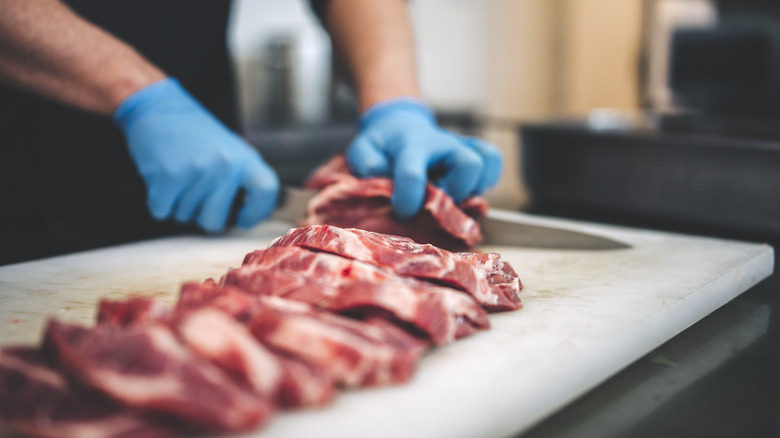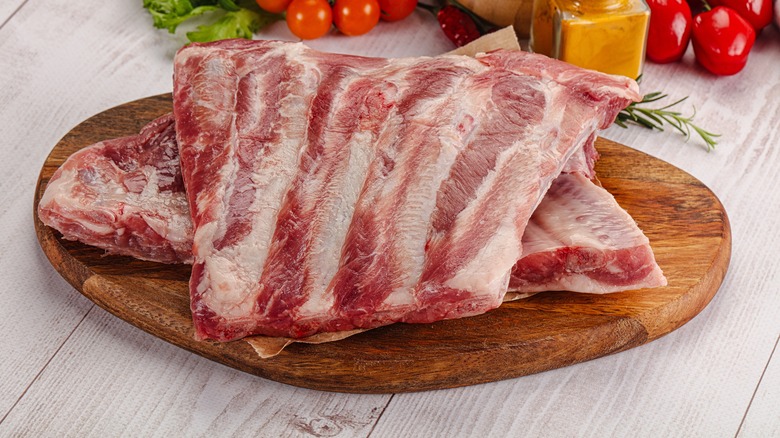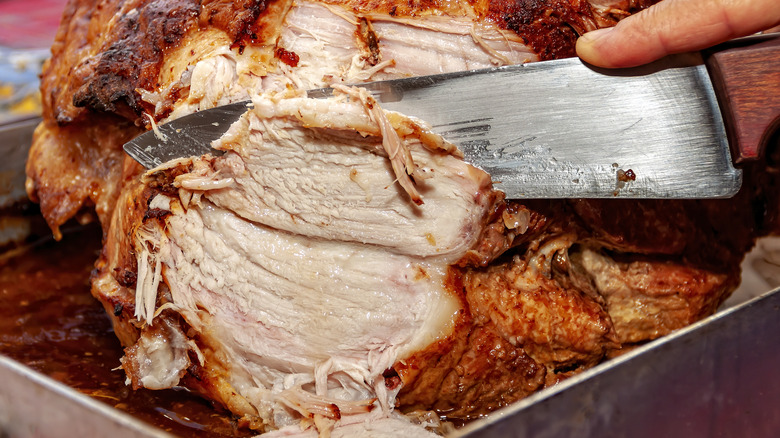The Easy-To-Make Mistake That Will Start Your Pork Dishes Off On The Wrong Foot
Preparing pork can yield great rewards — from delicious shredded meat to chops and roast, it shines in many forms. Yet achieving mouthwatering perfection comes with its own set of challenges. There's the threat of undercooking or leaning into fear of a terribly dry result, both critical pitfalls. And one of the biggest cooking mistakes ruining your pork may occur before you even start: Buying the wrong cut.
Sure, for certain dishes, the shape may seem hard to mix up — you can't mistake a rack of ribs, for example. But keep in mind that every region of the pig is split up into further cuts, and each come with different names. And as opposed to other meat types, pork doesn't isn't very malleable.
As a result, matching the cut you buy with the application can be a make-it-or-break situation. Not to mention when you select the best cut, you'll enhance the flavor and texture of your dish, too. By avoiding any mistakes in the grocery store, your pork dishes will come stress-free.
Use shoulder for pulled pork
Nailing succulent pulled pork may seem intimidating, but it's actually a fairly forgiving dish. The secret's all in patience, a nice blend of seasonings, and — most critically — using the right part of the pig. It's essential to settle on a cut that's rich in fat so when it melts, the result is a succulent tenderness. But the pork slab must come with meaty morsels, too — overly large pieces of fat or chewy collagen aren't suitable.
The pig's large shoulder region fits such criteria. Found above the front feet, this area has the ideal level of fat-marbling, creating a delicious flavor and texture. Only commercial barbecue restaurants prepare the entire shoulder primal cut, which usually weighs around 20 pounds. It's far more common to employ either the picnic shoulder or boston butt — two smaller parts of this pork region. Although both can be turned into pulled pork, the latter offers more advantages. Filled with more marbled fat, it lends to a more succulent result, helping even slow cooker pulled pork reach mouthwatering satisfaction.
Regardless of which section you employ, double-check that the skin's removed — ask a friendly butcher for help if necessary. And trim away any especially large chunks of fat, ensuring there's no sections with over ½ inch of thickness. If you settle for the shoulder and avoid leaner cuts like roasts or country ribs, you'll be rewarded with a tasty result.
Verse yourself in rib styles
Pork ribs are an iconic favorite: There's enduring allure to this meaty cut on the bone. It may seem like buying a pre-packaged set is all that's necessary to get started on a cookout, but it's a bit more complicated than that. Pork ribs hail from several regions, each with their own unique culinary attributes.
None are worth avoiding completely — as long as you're aware that country-style ribs come boneless and from a different part of the pig. So to prepare a rack in classic fashion, you'll want to settle on meat from the loin instead. The most well-known of such cuts are baby back ribs, which come small and lean (although still with enough fat for flavor). Due to their pleasant taste, curve, and approachable weight, this cut is a favorite among chefs, although it will need more attention to avoid drying it out.
If you're after a fattier, larger pork cut, spareribs are a great option. Their size may even be intimidating, although with the right technique (or a large smoker), they yield an especially flavorful result. For a similar experience that's less demanding, you can opt for the St. Louis style instead. With the excess trimmed away, this rib cut comes flat and uniform, making it a delight to cook with. It's the perfect candidate for the 3-2-1 method on a gas grill.
Select pork chops with care
Few pork preparations offer simplicity like the pork chop. Akin to a steak for beef, this is the well-sized cut ready for searing, grilling, or broiling. Just keep in mind that lots of pork pieces fall into this category — although they may not be sourced from the same origin. For this reason, it's crucial to know what kind you're buying, since many will list "pork chop" on the package.
Cuts like the rib, sirloin, and blade chop all come from completely different parts of the animal. Typically, the thicker the better, and a bone is a good sign of a tender result, too. The best region — which will also cook the most fuss-free — is the loin. You'll get a fatty and flavorful chop, especially when the cut is closer to the ribs, though it's accordingly pricey at the store. And if you're looking for something leaner without compromising taste, the center chop is a great choice.
However, even in the same region there are options that won't yield such a flavorful result. Closer to the hip, there's the sirloin chop, which is dry and flavorless. Somewhere in between are shoulder chops, which have a good amount of fat and flavor but a tough composition. With these, you'll want a tenderizer like a marinade. So although many chops have similar curved shapes, your choice of cut makes a big difference in the end result.
A variety of cuts are suitable for pork roast
The roast is a style of pork with a bit more versatility. From head to toe, there are plenty of pig regions that do well with low and slow cooking that turns the meat nice and succulent on the inside and crispy on the exterior. As with chops, most contain the word "roast" in their name.
Nevertheless, you will want to tailor your preparation style to the pork cut. Pork roasts from the loin are well-suited for the cooking method and are accordingly popular. Rib roasts are beloved for their rich porky flavor and internal moisture — they make slow-cooking fuss-free. Also from the loin, butchers make pork top roasts by tying together two loin cuts with the fat on the exterior. And don't sleep on blade roasts, which are a bit fattier but nonetheless a great purchase.
Meanwhile, the differences between pork tenderloin vs. loin are noticeable, so don't mix up the two cuts. While much leaner, the tenderloin does terrifically in oven applications, too — you'll just need to account for the smaller size. And even pork belly can be roasted to crispy perfection, so you have plenty of options.
There are a few cuts worth avoiding. Thin cuts like chops, cutlets, and deboned ribs are just too small and will dry out in the oven. Meanwhile, ham hocks look like they're worth slow-cooking, but there's not enough meat on the bone to justify it.
Know what to reach for when cooking ham
Ham likely makes you think of pork that's cured, pre-sliced, and already packaged. However, the term also refers to a specific subset of cuts that hail from the leg. So whether you're making a honey mustard-glazed ham for the holidays or trying your hand at curing, you'll want to know what you're buying.
First of all, understand the connection between the curing process and the meat itself. Brining is an often-used part of this cut's preparation process, since it helps tenderize the ham and add moisture. Some are also cured with a combination of nitrate, salt, or air, creating famed cuts like prosciutto or jamon iberico. Brining and curing don't define the cut — Canadian bacon is different from ham since it hails from a different region, but it's made with the same technique. So for the tastiest experience, you'll want a balance of fat, flavor and size. Plus, you'll want to consider the amount of bone for easy carving.
A section like a spiral-cut fits such criteria well, especially after a brine. Meanwhile, the shank or the sirloin half of the ham can be tasty, but they're trickier to work around. And with a section like country ham, you'll want to save for dry-curing. Even with only the leg, you need to consider the cut that will provide the best flavor.





